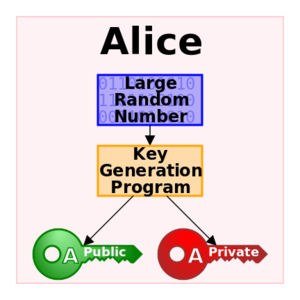Public-key cryptography (nonfiction)
Public key cryptography, or asymmetric cryptography, is any cryptographic system that uses pairs of keys: public keys which may be disseminated widely, and private keys which are known only to the owner.
This accomplishes two functions: authentication, which is when the public key is used to verify that a holder of the paired private key sent the message, and encryption, whereby only the holder of the paired private key can decrypt the message encrypted with the public key.
In a public key encryption system, any person can encrypt a message using the public key of the receiver, but such a message can be decrypted only with the receiver's private key. For this to work it must be computationally easy for a user to generate a public and private key-pair to be used for encryption and decryption.
The strength of a public key cryptography system relies on the degree of difficulty (computational impracticality) for a properly generated private key to be determined from its corresponding public key. Security then depends only on keeping the private key private, and the public key may be published without compromising security.
In the News
Fiction cross-reference
Nonfiction cross-reference
External links:
- Public-key cryptography @ Wikipedia
